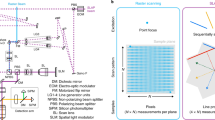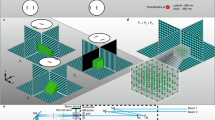Abstract
The dynamic ability of neuronal dendrites to shape and integrate synaptic responses is the hallmark of information processing in the brain. Effectively studying this phenomenon requires concurrent measurements at multiple sites on live neurons. Substantial progress has been made by optical imaging systems that combine confocal and multiphoton microscopy with inertia-free laser scanning. However, all of the systems developed so far restrict fast imaging to two dimensions. This severely limits the extent to which neurons can be studied, as they represent complex three-dimensional structures. Here we present a new imaging system that utilizes a unique arrangement of acousto-optic deflectors to steer a focused, ultra-fast laser beam to arbitrary locations in three-dimensional space without moving the objective lens. As we demonstrate, this highly versatile random-access multiphoton microscope supports functional imaging of complex three-dimensional cellular structures such as neuronal dendrites or neural populations at acquisition rates on the order of tens of kilohertz.
This is a preview of subscription content, access via your institution
Access options
Subscribe to this journal
Receive 12 print issues and online access
$209.00 per year
only $17.42 per issue
Buy this article
- Purchase on Springer Link
- Instant access to full article PDF
Prices may be subject to local taxes which are calculated during checkout






Similar content being viewed by others
References
Megias, M., Emri, Z., Freund, T.F. & Gulyas, A.I. Total number and distribution of inhibitory and excitatory synapses on hippocampal CA1 pyramidal cells. Neuroscience 102, 527–540 (2001).
Ambros-Ingerson, J. & Holmes, W.R. Analysis and comparison of morphological reconstructions of hippocampal field CA1 pyramidal cells. Hippocampus 15, 302–315 (2005).
Losonczy, A. & Magee, J.C. Integrative properties of radial oblique dendrites in hippocampal CA1 pyramidal neurons. Neuron 50, 291–307 (2006).
Frick, A., Magee, J., Koester, H.J., Migliore, M. & Johnston, D. Normalization of Ca2+ signals by small oblique dendrites of CA1 pyramidal neurons. J. Neurosci. 23, 3243–3250 (2003).
Helmchen, F., Svoboda, K., Denk, W. & Tank, D.W. In vivo dendritic calcium dynamics in deep-layer cortical pyramidal neurons. Nat. Neurosci. 2, 989–996 (1999).
Markram, H., Helm, P.J. & Sakmann, B. Dendritic calcium transients evoked by single back-propagating action potentials in rat neocortical pyramidal neurons. J. Physiol. (Lond.) 485, 1–20 (1995).
Kovalchuk, Y., Eilers, J., Lisman, J. & Konnerth, A. NMDA receptor-mediated subthreshold Ca2+ signals in spines of hippocampal neurons. J. Neurosci. 20, 1791–1799 (2000).
Yuste, R. & Denk, W. Dendritic spines as basic functional units of neuronal integration. Nature 375, 682–684 (1995).
Yuste, R., Majewska, A., Cash, S.S. & Denk, W. Mechanisms of calcium influx into hippocampal spines: heterogeneity among spines, coincidence detection by NMDA receptors and optical quantal analysis. J. Neurosci. 19, 1976–1987 (1999).
Sabatini, B.L. & Svoboda, K. Analysis of calcium channels in single spines using optical fluctuation analysis. Nature 408, 589–593 (2000).
Sabatini, B.L., Oertner, T.G. & Svoboda, K. The life cycle of Ca2+ ions in dendritic spines. Neuron 33, 439–452 (2002).
Hoogland, T.M. & Saggau, P. Facilitation of L-type Ca2+ channels in dendritic spines by activation of β2 adrenergic receptors. J. Neurosci. 24, 8416–8427 (2004).
Mainen, Z.F. et al. Two-photon imaging in living brain slices. Methods 18, 231–239 (1999).
Salome, R. et al. Ultrafast random-access scanning in two-photon microscopy using acousto-optic deflectors. J. Neurosci. Methods 154, 161–174 (2006).
Iyer, V., Hoogland, T.M. & Saggau, P. Fast functional imaging of single neurons using random-access multiphoton (RAMP) microscopy. J. Neurophysiol. 95, 535–545 (2006).
Bansal, V., Patel, S. & Saggau, P. High-speed addressable confocal microscopy for functional imaging of cellular activity. J. Biomed. Opt. 11, 34003 (2006).
Lv, X.H., Zhan, C., Zeng, S.Q., Chen, W.R. & Luo, Q.M. Construction of multiphoton laser scanning microscope based on dual-axis acousto-optic deflector. Rev. Sci. Instrum. 77, 046101 (2006).
Lechleiter, J.D., Lin, D.T. & Sieneart, I. Multi-photon laser scanning microscopy using an acoustic optical deflector. Biophys. J. 83, 2292–2299 (2002).
Saggau, P. New methods and uses for fast optical scanning. Curr. Opin. Neurobiol. 16, 543–550 (2006).
Zhu, L., Sun, P.C. & Fainman, Y. Aberration-free dynamic focusing with a multichannel micromachined membrane deformable mirror. Appl. Opt. 38, 5350–5354 (1999).
Oku, H., Hashimoto, K. & Ishikawa, M. Variable-focus lens with 1-kHz bandwidth. Opt. Express 12, 2138–2149 (2004).
Oron, D., Tal, E. & Silberberg, Y. Scanningless depth-resolved microscopy. Opt. Express 13, 1468–1476 (2005).
Durst, M.E., Zhu, G.H. & Xu, C. Simultaneous spatial and temporal focusing for axial scanning. Opt. Express 14, 12243–12254 (2006).
Babin, A.A., Kartashov, D.V. & Kulagin, D.I. Focusing femtosecond radiation with an axicon. IEEE J. Quantum Electron. 32, 308–310 (2002).
Dufour, P., Piche, M., De Koninck, Y. & McCarthy, N. Two-photon excitation fluorescence microscopy with a high depth of field using an axicon. Appl. Opt. 45, 9246–9252 (2006).
Gobel, W., Kampa, B.M. & Helmchen, F. Imaging cellular network dynamics in three dimensions using fast 3D laser scanning. Nat. Methods 4, 73–79 (2007).
Reddy, G.D. & Saggau, P. Fast three-dimensional laser scanning scheme using acousto-optic deflectors. J. Biomed. Opt. 10, 064038 (2005).
Iyer, V., Losavio, B.E. & Saggau, P. Compensation of spatial and temporal dispersion for acousto-optic multiphoton laser-scanning microscopy. J. Biomed. Opt. 8, 460–471 (2003).
Zeng, S. et al. Simultaneous compensation for spatial and temporal dispersion of acousto-optical deflectors for two-dimensional scanning with a single prism. Opt. Lett. 31, 1091–1093 (2006).
Vucinic, D. & Sejnowski, T.J. A compact multiphoton 3D imaging system for recording fast neuronal activity. PLoS. ONE 2, e699 (2007).
Bullen, A., Patel, S.S. & Saggau, P. High-speed, random-access fluorescence microscopy. I. High-resolution optical recording with voltage-sensitive dyes and ion indicators. Biophys. J. 73, 477–491 (1997).
Bullen, A. & Saggau, P. High-speed, random-access fluorescence microscopy. II. Fast quantitative measurements with voltage-sensitive dyes. Biophys. J. 76, 2272–2287 (1999).
Shoham, S., O'Connor, D.H., Sarkisov, D.V. & Wang, S.S.H. Rapid neurotransmitter uncaging in spatially defined patterns. Nat. Methods 2, 837–843 (2005).
Xu, J. & Stroud, R. Acousto-optic Devices: Principles, Design and Applications (John Wiley and Sons, New York, 1992).
Gottlieb, M., Ireland, C.R.E. & Ley, J.M. Electro-Optic and Acousto-Optic Scanning and Deflection (Marcel Dekker, New York, 1983).
Kaplan, A., Friedman, N. & Davidson, N. Acousto-optic lens with very fast focus scanning. Opt. Lett. 26, 1078–1080 (2001).
Siegman, A.E. Lasers (University Science Books, Sausalito, California, 1986).
Xu, J., Weverka, R.T. & Wagner, K.H. Wide angular–aperture acousto-optic devices. Proc. Soc. Photo. Opt. Instrum. Eng. 2754, 104–114 (1996).
Chang, I.C. Acousto-optic modulator with wide bandwidth and large angular aperture. Electron. Lett. 30, 1190–1191 (1994).
Sheppard, C.J.R. & Gu, M. Aberration compensation in confocal microscopy. Appl. Opt. 30, 3563–3568 (1991).
Kam, Z., Agard, D.A. & Sedat, J.W. Three-dimensional microscopy in thick biological samples: a fresh approach for adjusting focus and correcting spherical aberration. Bioimaging 5, 40–49 (1997).
Escobar, I., Saavedra, G., Martinez-Corral, M. & Lancis, J. Reduction of the spherical aberration effect in high numerical-aperture optical scanning instruments. J. Opt. Soc. Am. A Opt. Image Sci. Vis. 23, 3150–3155 (2006).
Koester, H.J., Baur, D., Uhl, R. & Hell, S.W. Ca2+ fluorescence imaging with pico- and femtosecond two-photon excitation: signal and photodamage. Biophys. J. 77, 2226–2236 (1999).
Hopt, A. & Neher, E. Highly nonlinear photodamage in two-photon fluorescence microscopy. Biophys. J. 80, 2029–2036 (2001).
McConnell, G. Improving the penetration depth in multiphoton excitation laser scanning microscopy. J. Biomed. Opt. 11, 54020 (2006).
Helmchen, F. & Denk, W. Deep tissue two-photon microscopy. Nat. Methods 2, 932–940 (2005).
Treacy, E.B. Optical pulse compression with diffraction gratings. IEEE J. Quantum Electron. 5, 454–458 (1969).
Mogilevtsev, D., Birks, T.A. & Russell, P.S. Group-velocity dispersion in photonic crystal fibers. Opt. Lett. 23, 1662–1664 (1998).
Acknowledgements
We thank Y. Liang for his contributions to the neurophysiology experiments. This project was supported by grants from the US National Institutes of Health and the National Science Foundation to P.S.
Author information
Authors and Affiliations
Contributions
G.D.R. designed the microscope, performed the initial experiments and wrote the manuscript. K.K. carried out the neurophysiological experiments and R.F. designed the software. P.S. Conceived the three-dimensional scanning and supervised the project.
Corresponding author
Supplementary information
Supplementary Text and Figures
Supplementary Figure 1 (PDF 762 kb)
Rights and permissions
About this article
Cite this article
Duemani Reddy, G., Kelleher, K., Fink, R. et al. Three-dimensional random access multiphoton microscopy for functional imaging of neuronal activity. Nat Neurosci 11, 713–720 (2008). https://doi.org/10.1038/nn.2116
Received:
Accepted:
Published:
Issue Date:
DOI: https://doi.org/10.1038/nn.2116
This article is cited by
-
Fast optical recording of neuronal activity by three-dimensional custom-access serial holography
Nature Methods (2022)
-
Silent microscopy to explore a brain that hears butterflies’ wings
Light: Science & Applications (2022)
-
Two-photon calcium imaging of neuronal activity
Nature Reviews Methods Primers (2022)
-
Optical gearbox enabled versatile multiscale high-throughput multiphoton functional imaging
Nature Communications (2022)
-
Whole brain functional recordings at cellular resolution in zebrafish larvae with 3D scanning multiphoton microscopy
Scientific Reports (2021)



